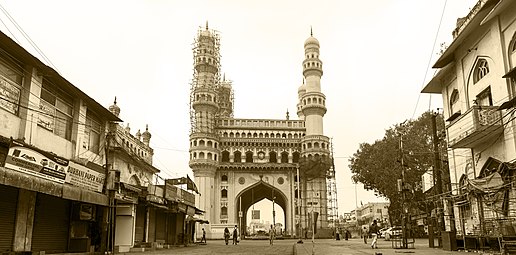
The Charminar constructed in 1591, is a monument and mosque located in Hyderabad, Telangana, India. The Charminar's long history includes the existence of a mosque on its top floor for more than 400 years. While both historically and religiously significant, it is also known for the popular and busy local markets surrounding the structure, and has become one of the most frequented tourist attractions in Hyderabad. Charminar is also a site of numerous festival celebrations, such as Eid-ul-adha and Eid-ul-fitr.

The Charminar is situated on the east bank of Musi River. To the west lies the Laad Bazaar, and to the southwest lies the richly ornamented granite Makkah Masjid. It is listed as an archaeological and architectural treasure on the official "List of Monuments" prepared by the Archaeological Survey of India. The English name is a translation and combination of the Urdu words ch?r and minar or meenar, translating to "Four Pillars"; the eponymous towers are ornate minarets attached and supported by four grand arches.
The Charminar has become known globally as a symbol of Hyderabad and is listed among the most recognized structures in India. The Charminar masjid is a square structure with each side being 20 meters (approximately 66 feet) long. Each of the four sides has one of four grand arches, each facing a fundamental point that opens directly onto the street in front of it. At each corner stands an exquisitely shaped, 56 meter-high (approximately 184 feet) minaret, with a double balcony.
Each minaret is crowned by a bulbous dome with dainty, petal-like designs at the base. Unlike the minarets of Taj Mahal, Charminar's four fluted minarets are built into the main structure. There are 149 winding steps to reach the upper floor. The structure is also known for its profusion of stucco decorations and the arrangement of balustrades and balconies.
The structure is made of granite, limestone, mortar, and pulverized marble, weighing approximately 14,000 tones apiece. Initially the monument was so proportionately planned that when the fort first opened, one could see all four corners of the bustling city of Hyderabad through each of its four grand arches, as each arch faced one of the most active royal ancestral streets.
A mosque is located at the western end of the open roof. The remaining section of the roof served as a royal court during the Qutb Shahi times. The actual mosque occupies the top floor of the four-storey structure. A vault which appears from inside like a dome supports two galleries within the Charminar, one over another. Above those is a terrace that serves as a roof that is bordered with a stone balcony. The main gallery has 45 covered prayer spaces with a large open space in front to accommodate more people for Friday prayers.
The clock on the four cardinal directions was added in 1889. There is a vazu (water cistern) in the middle with a small fountain for ablution before offering prayer in the Charminar mosque.

The fifth ruler of the Qutb Shahi dynasty, Muhammad Quli Qutb Shah, built the Charminar in 1591 after shifting his capital from Golkonda to the newly formed city of Hyderabad. The Archaeological Survey of India (ASI), the current caretaker of the structure, mentions in its records, "There are various theories regarding the purpose for which Charminar was constructed. However, it is widely accepted that Charminar was built at the center of the city, to commemorate the eradication of Cholera", a deadly disease which was wide spread at that time.

According to Jean de Thévenot, a French traveller of the 17th century whose narration was complemented with the available Persian texts, the Charminar was constructed in the year 1591 CE, to commemorate the beginning of the second Islamic millennium year (1000 AH). The event was celebrated far and wide in the Islamic world, thus Qutb Shah founded the city of Hyderabad to celebrate the event and commemorate it with the construction of this building. 17–19Due to its architecture it is also called as Arc de Triomphe of the east.

The Charminar was constructed at the intersection of the historical trade route that connects the markets of Golkonda with the port city of Machilipatnam. The Old City of Hyderabad was designed with Charminar as its centerpiece. The city was spread around the Charminar in four different quadrants and chambers, segregated according to the established settlements. Towards the north of Charminar is the Char Kaman, or four gateways, constructed in the cardinal direction. Additional eminent architects from Persia were also invited to develop the city plan. The structure itself was intended to serve as a Mosque and Madarsa. It is of Indo-Islamic architecture style, incorporating Persian architectural elements.
Historian Masud Hussain Khan says that the construction of Charminar was completed in the year 1592, and that it is the city of Hyderabad which was actually founded in the year 1591. According to the book "Days of the Beloved", Qutb shah constructed the Charminar in the year 1589, on the very spot where he first glimpsed his future queen Bhagmati, and after her conversion to Islam, Qutb Shah renamed the city as "Hyderabad". Though the story was rejected by the historians and scholars, it became popular folklore among the locals.